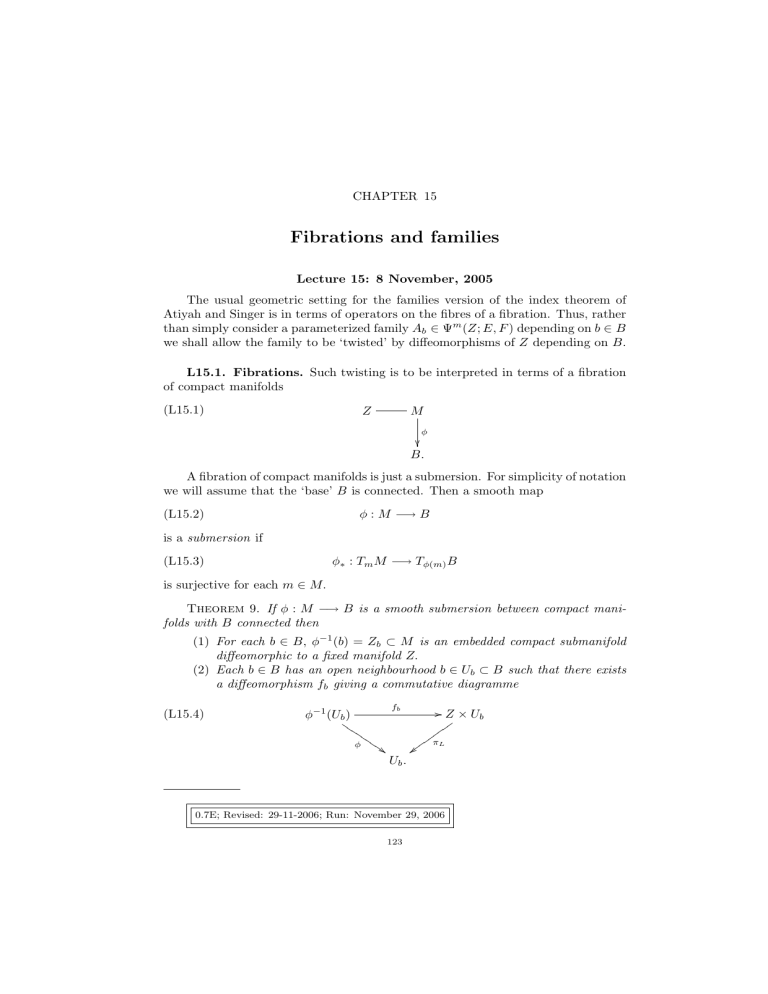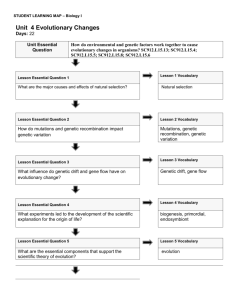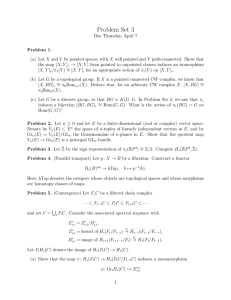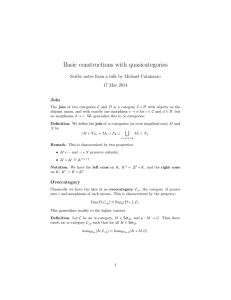Fibrations and families
advertisement

CHAPTER 15
Fibrations and families
Lecture 15: 8 November, 2005
The usual geometric setting for the families version of the index theorem of
Atiyah and Singer is in terms of operators on the fibres of a fibration. Thus, rather
than simply consider a parameterized family Ab ∈ Ψm (Z; E, F ) depending on b ∈ B
we shall allow the family to be ‘twisted’ by diffeomorphisms of Z depending on B.
L15.1. Fibrations. Such twisting is to be interpreted in terms of a fibration
of compact manifolds
(L15.1)
M
Z
φ
B.
A fibration of compact manifolds is just a submersion. For simplicity of notation
we will assume that the ‘base’ B is connected. Then a smooth map
(L15.2)
φ : M −→ B
is a submersion if
(L15.3)
φ∗ : Tm M −→ Tφ(m) B
is surjective for each m ∈ M.
Theorem 9. If φ : M −→ B is a smooth submersion between compact manifolds with B connected then
(1) For each b ∈ B, φ−1 (b) = Zb ⊂ M is an embedded compact submanifold
diffeomorphic to a fixed manifold Z.
(2) Each b ∈ B has an open neighbourhood b ∈ Ub ⊂ B such that there exists
a diffeomorphism fb giving a commutative diagramme
(L15.4)
φ−1 (Ub )
HH
HH
HH
φ HHH
#
fb
Ub .
/ Z × Ub
w
ww
wπw
w
w L
w{ w
0.7E; Revised: 29-11-2006; Run: November 29, 2006
123
124
15. FIBRATIONS AND FAMILIES
(3) For each intersectiong pair of such open sets it follows that there is a
commutative diagramme
(L15.5)
fb ′
fb
/ Z × (Ub ∩ Ub′ )
Z × (Ub ∩ Ub′ ) o
φ−1 (Ub ∩ Ub′ )
QQQ
m
QQQπL
mmm
QQQ
mπmm
φ
m
QQQ
m
m L
Q(
vmmm
Ub ∩ Ub′
which shows that fb′ b = fb′ fb−1 ∈ C ∞ (Ub ∩ Ub′ ; Difm(Z)) is a smooth map
into the diffeomorphisms of Z and also that the cocycle condition
(L15.6)
fb′′ b′ fb′ b = fb′′ b holds on Ub′′ ∩ Ub′ ∩ Ub .
Proof. (Brief) The implicit function theorem shows that Zb = φ−1 (b) is an
embedded compact submanifold of M. Indeed, if ti are local coordinates near b on
B then the φ∗ (ti ) are defining functions for Zb in M. One can choose commuting
vector fields in φ−1 (Ub ) for a sufficiently small neighbourhood Ub of b, Ti on φ−1 (Ub )
such that φ∗ (Ti ) = ∂ti and then by integration along the Ti one can define fb with
Z = Zb . Having done this on an open covering of B it follows that all the Zb are
diffeomorphic, so Zb can be replaced by a fixed Z in (L15.4). This proves (1) and
(2) and (3) follow directly from (2).
One can recover the fibration, thought of here as a fibre bundle with fibre Z and
structure group Difm(Z) (the diffeomorphism group of Z), from (2) and (3). If the
maps fb′ b can be chosen, for some covering of B, to lie in a subgroup G ⊂ Difm(Z)
of the diffeomorphism group, then the structure group is ‘reduced to G.’
Fibrations have various functoriality properties. The most important for us
is that we may restrict to a submanifold of the base or more generally we may
‘pull-back’ a fibration.
Proposition 31. If F : B̃ −→ B is any smooth map, with B̃ compact, and
φ : M −→ B is a fibration, then
(L15.7)
M̃ = {(m, b̃) ∈ M × B̃; φ(m) = F (b̃)} is an embedded submanifold of M × B and
φ̃ : M̃ −→ B̃, φ̃(m, b̃) = b̃ is a fibration.
Equally important is that the composite of two fibrations is a fibration.
Proposition 32. If φ′ : M ′ −→ M is a fibration with typical fibre Z ′ and
φ : M −→ B is a fibration with typical fibre Z then φφ′ : M ′ −→ B is a fibration
with typical fibre Z × Z ′ .
It is also easy to see that the direct product of two fibrations, φi : Mi −→ Bi ,
i = 1, 2 is a fibration
(L15.8)
φ1 × φ2 : M1 × M2 −→ B1 × B2 .
In the proof of the Atiyah-Singer index theorem discussed below, a given fibration is trivialized by embedding, so it is important to see that this is always
possible.
Exercise 19. Given a fibration (of compact manifolds always) φ : M −→ B
show that there is an embedding e : M −→ SN × B with range in (SN \ {p}) × B
LECTURE 15: 8 NOVEMBER, 2005
125
for fixed point p ∈ SN such that
(L15.9)
e
M@
@@
@@
@
φ @@
B
/ SN × B
ww
ww
w
ww πL
w{ w
commutes.
Hint: This is not hard, just use Whitney’s theorem to embed M in a big sphere,
staying away from one point, and then define e as the product of that embedding
and φ. Check that this is an embedding and that (L15.9) holds.
L15.2. Pseudodifferential operators on the fibres. Next we turn to the
definition of pseudodifferential operators ‘on the fibres’ of a fibration. We could
proceed locally from (L15.4) and (L15.5), using the definition of pseudodifferential
operators on Z depending on a parameter and then the invariance under diffeomorphisms to piece these together between patches. However we are in a position to
proceed more directly than this.
The standard notation for pseudodifferential operators on the fibres of a fibration φ : M −→ B is Ψm (M/B; E, F ), where E and F are bundles over M. Note
that the fibration φ does not appear explicitly in the notation, which is designed (I
suppose) to suggest the the operators are on ‘M/B’ which does not mean anything
but could only be interpreted as the fibre.
Given a fibration φ : M −→ B we first define the fibre-product of this fibration
with itself, Mφ2 −→ B. Namely, Mφ2 is the restriction of M × M, as a fibration over
B × B, to the diagonal B ≡ Diag ⊂ B × B. The total space in then
(L15.10)
Mφ2 = M ×φ M = {(m, m′ ) ∈ M × M ; φ(m) = φ(m′ )}.
Thus the fibres of Mφ2 −→ B, (where I use the same letter for the new fibration)
are modelled on Z × Z. Clearly the diagonal in M 2 is contained in Mφ2 where we
may think of it as the ‘fibre diagonal’ Diagφ so we have the embedded submanifold
(L15.11)
M ≡ Diagφ ֒→ Mφ2 .
Definition 6. The space of pseudodifferential operators on the fibres of a
fibration φ : M −→ B is identified as
′
1
(L15.12) Ψm (M/B; E, F ) = I m (Mφ2 , Diagφ ; Hom(E, F )⊗ΩR ), m′ = m− dim B
4
for any complex vector bundles E and F over M ; here ΩR is the bundle of fibrewise
densities on the right, discussed more below.
Note that if M = Z × B is ‘trivial’ and E, F are the lifts of bundles over Z
then
′
I m (Mφ2 , Diagφ ; Hom(E, F ) ⊗ ΩR ) = C ∞ (B; Ψm (Z; E, F )).
Thus, locally over U ⊂ B over which the fibration is trivial and so small that E and
F are the pull-backs of their restrictions Eb and Fb to Zb , Ψm (M/B; E, F ) reduces
to C ∞ (U ; Ψm (Z; Eb , Fb )). From this, and the definition, we can deduce all the basic
properties.
In general, elements of Ψm (M/B; E, F ) cannot be elements of Ψm (M ; E, F )
since the latter have kernels singular only on the diagonal of M whereas the kernels
126
15. FIBRATIONS AND FAMILIES
of the fibrewise operators are supported on Mφ2 . In fact the only elements in both
are fibrewise differential operators (assuming the dimension of the base is positive).
(1) (Action) The elements of Ψm (M/B; E, F ) are continuous linear operators
Ψm (M/B; E, F ) ∋ A : C ∞ (M ; E) −→ C ∞ (M ; F ).
(L15.13)
Indeed, locally over any small open set, U ⊂ B, u ∈ C ∞ (M, E) becomes
ub ∈ C ∞ (U × Z; Eb ) and A maps this to C ∞ (U × Z; Fb ). Alternatively
we can go back to the proof in the case of a single manifold and use the
push-forward theorem.
These operators clearly act on the fibres. That is, if u ∈ C ∞ (M ; E)
and u Z = 0 then Au Z = 0. Hence Ab is well-defined by
b
b
(L15.14) Ab v = (Au)
∞
Zb
, u ∈ C (M ; E) s.t. u
Zb
= v and Ab ∈ Ψm (Zb ; Eb , Fb ).
(2) (Smoothing operators) The smoothing families are
(L15.15)
Ψ−∞ (M/B; E, F ) = C ∞ (Mφ2 ; Hom(E, F ) ⊗ ΩR ).
(3) (Symbol map) For each point b ∈ B the symbol of Ab , where A ∈
Ψm (M/B; E, F ), is an element of C ∞ (S ∗ Zb ; hom(Eb , Fb ) ⊗ Nm ) and in
terms of a local trivialization of the fibration and bundles (i.e. local reduction to a product) depends smoothly on b. Let T (M/B) be the subbundle
of T M consisting of the vectors tangent to the fibre at each point. Thus,
restricted to Zb , T (M/B) reduces to T Zb . Let T ∗ (M/B) be the dual bundle and S ∗ (M/B) be the corresponding sphere bundle. Then, from the
local properties, the symbol map becomes
(L15.16)
σm : Ψm (M/B; E, F ) −→ C ∞ (S ∗ (M/B); hom(E, F ) ⊗ Nm )
where as usual, Nm is the bundle of functions homogeneous of degree m
on T ∗ (M/B) (as a bundle over S ∗ (M/B)).
(4) (Symbol sequence) The symbol map leads immediately to the short exact
sequence
(L15.17)
/ Ψm (M/B; E, F ) σm / C ∞ (S ∗ (M/B); hom(E, F ) ⊗ Nm ).
Ψm−1 (M/B; E, F )
(5) (Composition) Of course one of the most important properties of pseudodifferential operators is that they compose to give such operators. Agian
it follows directly from the local picture, or using the same proofs as there
but in the more global setting, that
(L15.18)
′
′
A ∈ Ψm (M/B; F, G), B ∈ Ψm (M/B; E, F ) =⇒ AB ∈ Ψm+m (M/B; E, G) and
σm+m′ (AB) = σm (A)σm′ (B).
(6) (Ellipticity) A ∈ Ψm (M/B; E, F ) is said to be elliptic (as a family) if each
Ab is elliptic, which is the same as saying that the symbol has an inverse
(L15.19)
(σm (A))−1 ∈ C ∞ (S ∗ (M/B); hom(F, E) ⊗ Nm )
Then, as in the case of a single operator, the ellipticity of A is equivalent
to the existence of a two-sided parametrix Q ∈ Ψ−m (M/B; F, E) such
that
(L15.20)
QA − IdF ∈ Ψ−1 (M/B; F ), AQ − IdE ∈ Ψ−1 (M/B; E).
LECTURE 15: 8 NOVEMBER, 2005
127
(7) (Asymptotic completeness) Using just the corresponding fact for conormal
distributions we know that given a sequence Aj ∈ Ψm−j (M/B; E, F ) for
j ∈ N0 ,
(L15.21)
∃ A ∈ Ψm (M/B; E, F ) s.t. A ∼
X
Aj ⇐⇒ A −
N
X
Aj ∈ Ψm (M/B; E, F )
j=0
j
−∞
and A is unique modulo Ψ (M/B; E, F ).
Using these properties we can improve the parametrix for an elliptic operator
from (L15.20). Namely let Q0 be that operator, so
Q0 A = Id −R, R ∈ Ψ−1 (M/B; E).
P j
R is asymptotically summable,
Then the formal Neumann series for (Id −R)−1 ,
(L15.22)
j
as is the product on the left with Q0 . Thus we can find
X
(L15.23) Q ∼
Rj Q0 ∈ Ψ−m (M/B; F, E) =⇒ QA − IdE ∈ Ψ−∞ (M/B; E).
j
Similarly a right parametrix modulo smoothing operators can be constructed and
shown to be equal to Q modulo smoothing, so Q also satisfies
AQ − IdF ∈ Ψ−∞ (M/B; F ).
L15.3. The analytic index. Now, we can proceed very much as in the case of
the Toeplitz operators to discuss the families index theorem. Of course the geometry
of the fibration M will cause complications. In fact we need another basic fact to
proceed (the way I want, there are other approaches), namely a replacement for
the projections on the first k terms in the Fourier series on the circle.
Proposition 33. For any fibration of compact manifolds, φ : M −→ B there is
a sequence of projections πN ∈ Ψ−∞ (M/B; E), for any vector bundle E, satisfying
(L15.24)
rank(πN ) ≤ N, AπN −→ A for any A ∈ Ψ−∞ (M/B; E, F )
in terms of the usual topology on C ∞ (Mφ2 ; Hom(E, F ) ⊗ ΩR ).
Note that I am not assuming here that the projections are increasing, so it may
be that πN πN +1 6= πN (and this product may not even be a projection).
Proof. Missing – I do not yet have a reasonably elementary proof of this.
There is one using Kuiper’s theorem which I will resort to if necessary but I am
still hoping to find something a bit better than that! It is pretty easy to do this in
case of a product Z × B but the twisting of the bundle causes some trouble.
Assuming the existence of such a family of projections we can proceed as in
the Toeplitz case to construct the analytic index. Thus, given an elliptic family
A ∈ Ψm (M/B; E, F ) choose a parametrix Q ∈ Ψ−m (M/B; F, E) as above, i.e.
satisfying (L15.23), so QA = Id −R, with R ∈ Ψ−∞ (M/B; E). Then RπN −→ R
for a family of projections as in Proposition 33 and hence for N sufficiently large,
(Id −R(Id −πN ))−1 exists and is of the form Id −S with S ∈ Ψ−∞ (M/B; E). Thus,
for N sufficiently large,
(L15.25)
(Id −S)QA(Id −πN ) = Id −ΠN
128
15. FIBRATIONS AND FAMILIES
from which it follows that
(L15.26)
null(A(Id −πN )) = Ran(πN ) is a bundle over B.
It follows from this (just work locally as usual) that
(L15.27)
null((Id −πN )∗ A∗ ) is a bundle over B
again of finite rank – for any choice of inner products and smooth densities used to
define the adjoints. This latter bundle is a complement to the range of A(Id −πN )
as a subbundle of C ∞ (M/B; E) thought of as a bundle over B.
Proposition 34. For any elliptic family in Ψm (M/B; E, F ) the symbol determines an element of Kc∗ (T ∗ (M/B)) and the regularized null bundles in (L15.26)
and (L15.27) determine an element of K 0 (B) and this correspondence projects to
a well-defined map
(L15.28)
inda : Kc0 (T ∗ (M/B)) −→ K 0 (B).
Proof. We need to show independence of the choice of πN , independence of
the choice of A, given the symbol, homotopy invariance under deformation of the
symbol (which amounts to homotopy invariance for A) constancy of the index class
under stablization and under composition of the symbol with bundle isomorphisms;
of course we also need to check that every compactly supported K-class on T ∗ (M/B)
arises from a symbol. All of this is pretty straightforward and pretty much as in
the Toeplitz case.
Next time I will introduct the algebra of product-type pseudodifferential operators on a fibration which I will use to identify this analytic index map with the
topological index map defined by embedding of the fibration. This is the index
theorem of Atiyah and Singer.
15+. Addenda to Lecture 15
15+.1. Some more details.
15+.2. The analytic index map (L15.28).



